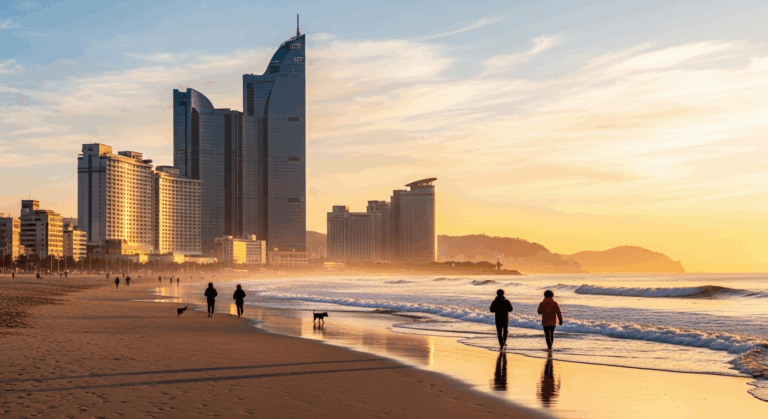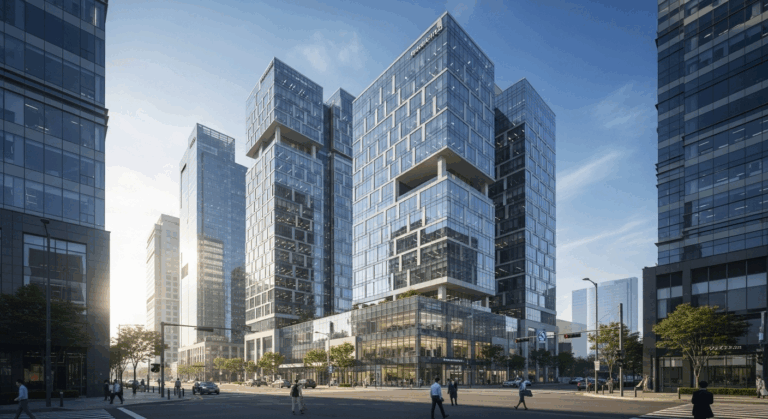If you’re trying to find an apartment in Busan, you’re not alone.
When I first started meeting foreigners who had just moved to Busan,
I noticed one common problem — finding a place to live was confusing for almost everyone.
The Korean rental system is completely different from what many people are used to.
Words like jeonse (전세), wolse (월세), and bojeung-geum (보증금) can be overwhelming at first.
As a Busan local, I’ve seen countless expats, students, and workers struggle to understand how it all works.
Luckily, my wife is a licensed real estate agent,
so I’ve learned a lot about the rental process, legal documents, and how to avoid common mistakes.
Many newcomers ask me how to find an apartment in Busan, because the system here feels so different.
In this post, I’ll share what I’ve learned —
from the types of housing available in Busan to real tips that locals actually use when renting a home.
If you’re about to start your Busan life, I hope this helps you feel a little more confident before you sign that contract.
1) How to Find an Apartment in Busan: Housing Types
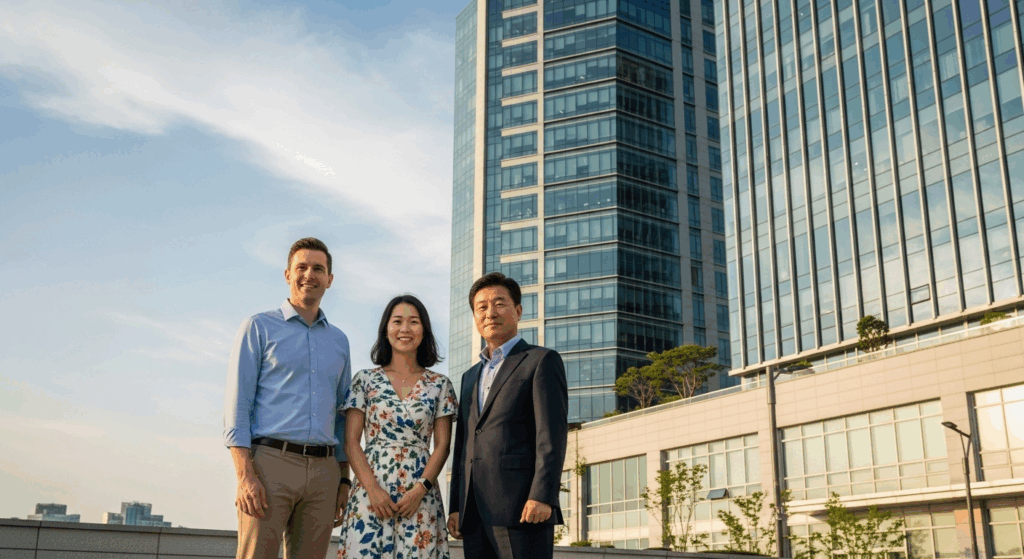
Before you start exploring how to find an apartment in Busan, it’s good to know what each housing type means.
Think of officetel, villa, apartment, one-room as four different “lifestyles,” not just buildings.
Officetel (오피스텔)
An officetel is a studio in a mixed-use building where lower floors might be offices or cafés and upper floors are residential. Most officetels are close to subway stations, have a lobby with security, and sometimes a small gym or parcel lockers. Inside, expect a clean studio with a kitchenette, built-in closets, and a washer. It’s popular with singles and short-term professionals because you can move in fast and don’t need to buy much furniture.
- Example: You work in Centum City and want a 10–15 minute commute. An officetel near Centum City Station lets you walk to work, grab coffee downstairs, and receive packages safely in the lobby lockers.
Villa (빌라)
A villa is a low-rise (usually 4–5 floors) walk-up building in residential streets. It’s cheaper than officetels/apartments, rooms are often a bit bigger for the price, but you may not have an elevator or on-site management. Soundproofing varies by building age. Great if you want value and don’t mind stairs.
- Example: A couple wants a separate bedroom and a small living room under ₩700,000/month. They find a 2-room villa in Yeonsan with good sunlight. No elevator, but quiet neighbors and a park nearby.
Apartment (아파트)
High-rise complexes with gated entrances, CCTV, elevators, underground parking, and community management (관리사무소). They feel the most “organized”: regular trash collection points, maintenance staff, playgrounds, sometimes small shops inside the complex. They’re ideal for families and long stays, but cost the most.
- Example: A family with a child chooses a Dongnae apartment for safety, playgrounds, and nearby elementary schools. The fees are higher, but the environment is stable and kid-friendly.
One-room (원룸)
Very compact studios, often near universities or busy hubs like Seomyeon. Cheapest to start, and many are furnished. Good for short stays, interns, or students who prioritize price and location over space.
- Example: An exchange student studies at PNU (Busan National University) and rents a one-room within a 5-minute walk to campus. Small, but easy.
How to choose quickly:
- 6 months or less? One-room or officetel (fast move-in, minimal furniture).
- Long-term with family? Apartment (safest and most structured).
- Budget but want more space? Villa (check noise and sunlight carefully).
2) Korea’s rental systems — jeonse vs wolse without the headache
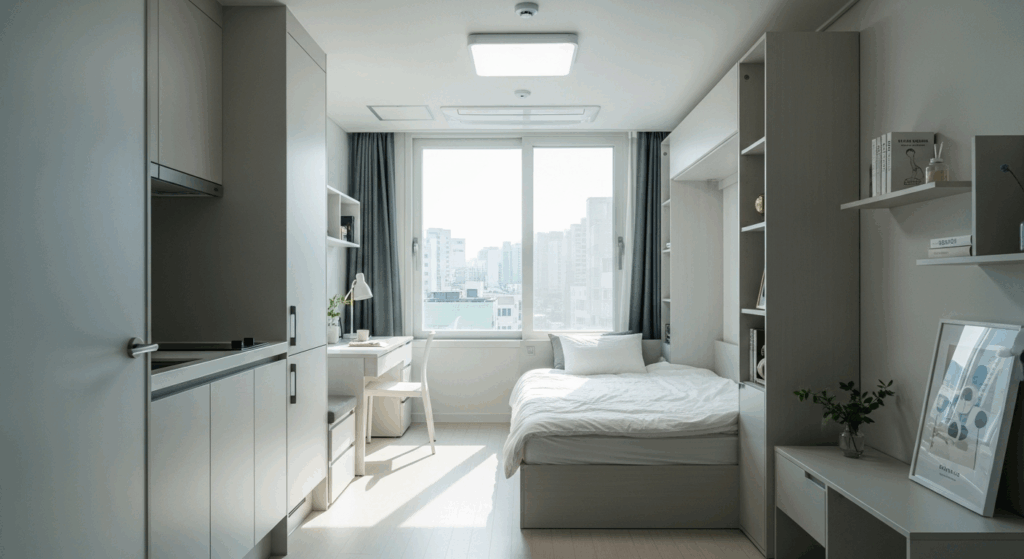
Anyone learning how to find an apartment in Busan will hear these two terms first — jeonse and wolse.
Korea mainly uses jeonse (전세) and wolse (월세). Think of them as two different financial models:
Jeonse (large deposit, no monthly rent)
You pay a big deposit (often 50–80% of the property’s value) to the landlord. There’s no monthly rent. At the end of the contract, you get your deposit back in full, assuming no damage/unpaid bills. It’s popular with locals who have savings because the monthly cost is near zero.
- Simple example: An apartment’s jeonse price is ₩200,000,000. You transfer ₩200M as a deposit, then pay only maintenance and utilities each month. After 2 years, you move out and the landlord returns the ₩200M.
- Pros: Lowest monthly burn; good for long stays and disciplined savers.
- Watch-outs: You must verify ownership and liens (등기부등본). If the landlord has heavy loans or tries to sell, your deposit could be at risk. Use a certified agent, register the lease, and consider jeonse deposit insurance if available.
Wolse (smaller deposit, monthly rent)
You pay a smaller deposit plus a fixed monthly rent. This feels familiar to most foreigners.
- Simple example: Deposit ₩5,000,000 and ₩700,000/month rent. Add 관리비 (maintenance) ₩80,000 and average utilities ₩120,000 → your real monthly outflow ≈ ₩900,000.
- Pros: Lower upfront cash, easier screening for foreigners, more listings available.
- Watch-outs: Confirm what’s included in rent (some places include internet or water), and check for rate changes on renewal.
Short-term / month-to-month
Near beaches and universities you’ll find flexible leases (furnished, higher monthly price). Good for testing areas before committing to a 1–2 year contract.
- Tip: If you’re unsure about Busan districts, take a 1–3 month short-term place first, learn the city, then sign a longer lease with confidence.
What beginners often miss:
- Realtor fee (중개보수): usually 0.3–0.9 months’ rent (wolse) or a % tier for jeonse. Budget this once at move-in.
- Maintenance fee (관리비) is separate from rent: elevators, cleaning, security. Ask for the average last 3 months.
- Registration: After signing, report your lease (임대차 신고) and register your address at the district office within 14 days—this protects you and is needed for visas/schools.
3) Where to Find an Apartment in Busan: Apps & Agents

Start with apps to learn the market price.
Browse Zigbang (직방) and Dabang (다방) to understand typical rents by area and building type. Use filters: price range, deposit, distance to subway, floor level, and “full option (풀옵션)” if you need furniture. Treat app photos as marketing—nice to preview, but not the full truth.
Then step into a certified real estate office (공인중개사).
The easiest way to learn how to find an apartment in Busan safely is to visit a certified real estate office.
Look for the blue sign that literally says “공인중개사.” Agents typically cover several nearby buildings and know which landlords are foreigner-friendly. Walk in with a clear brief:
- Budget (total monthly you can afford, including 관리비)
- Preferred areas (e.g., Gwangalli for beach, Yeonsan for quiet commute)
- Must-haves (sunlight, elevator, pet policy, parking, furnished, top floor vs mid-floor)
How a typical day goes:
- You show your filters and commute needs.
- The agent lines up 2–4 viewings within walking or short driving distance.
- You visit, check sunlight (south-facing is prized), noise, water pressure, mold around windows, and cell signal.
- If you like one, you ask for recent utility averages and 관리비 breakdown.
- Before committing, the agent pulls the property registration (등기부등본) to confirm ownership and loans.
- You negotiate deposit/rent or small fixes (e.g., replace an old fridge), then sign.
Use maps like a local.
Open Naver Map to verify actual walking time to subway exits (some exits are far apart), nearest bus stops, and grocery/clinics. In Busan’s hilly areas, a “500m walk” can feel like a hike—check elevation lines and street photos.
Community groups help—but stay cautious.
Foreigner Facebook groups or university communities sometimes post sublets. These can be convenient, but never pay any deposit without seeing the place and verifying the poster’s identity and the landlord’s approval. If anything feels rushed or unclear, switch to a certified agent.
A quick, safe search plan for first-timers:
- Day 1–2: Learn price ranges on apps; shortlist 2–3 neighborhoods.
- Day 3: Visit two different agents in your top area—compare options and fees.
- Day 4: Tour 3–4 units. Take photos and write notes (sunlight, noise, smell, storage).
- Day 5: Choose one, review 등기부등본, confirm costs (rent, deposit, 관리비, internet), and sign.
- Day 6–7: Transfer deposit via bank, schedule move-in cleaning, set up utilities/internet.
Red flags my wife (licensed agent) always mentions:
- “Too cheap for the area” with vague photos → often a bait listing.
- Agent refuses to show 등기부등본 or says “no need” → walk away.
- Landlord pushes cash deposit instead of bank transfer → refuse; always keep records.
- Facebook DM pressuring you to send money before viewing → block/report.
4) What documents you need & how the contract really works

Many foreigners tell me the scariest part is signing the contract—lots of Korean paperwork, numbers, and stamps.
Let me walk you through it step by step, the same way I’d explain to a friend.
If you’re still figuring out how to find an apartment in Busan, prepare your ARC, passport, and bank account first.
1️⃣ Passport – for ID.
2️⃣ ARC (Alien Registration Card) – the number is required on most contracts.
3️⃣ Korean bank account – for deposit and rent transfers.
4️⃣ Korean phone number – agents and landlords contact you by KakaoTalk or text.
The viewing process
Once you find a few options, your real-estate agent (공인중개사) will schedule viewings. In Busan, agents usually drive you from one place to another. Take pictures, videos, and ask direct questions:
- “How much is the maintenance fee (관리비)?”
- “Is the deposit negotiable?”
- “When was this building built?”
You don’t have to decide right away. Most landlords expect you to visit at least two or three places first.
When you decide on one place
1️⃣ You tell the agent, “I’ll take it.”
2️⃣ You pay a small reservation deposit (계약금) — usually about 5–10 % of the total deposit.
3️⃣ Within a few days, you sign the official lease contract (임대차 계약서).
- The standard contract has three copies (tenant, landlord, agent).
- It lists deposit, monthly rent, contract length (often 2 years), and move-in date.
4️⃣ The remaining deposit is transferred by bank on the move-in date. Never hand over cash.
Important local habit
Every agent checks the property registration document (등기부등본) before signing. It confirms who owns the place and whether any loans exist on the building. Ask to see it even if they don’t offer—it’s your right.
After you move in
Within 14 days you must report your new address (전입신고) at the district office (구청).
Bring your passport, ARC, and the lease contract.
If you’re under a jeonse or long wolse contract, also complete lease report (임대차 신고) there—this officially protects your deposit under Korean law.
Before you find an apartment in Busan, check these local tips.
💡 Local tip: If your landlord seems kind but says “no need to register,” don’t skip it.
Registration is your proof if anything goes wrong later.
5) Choosing the right neighborhood in Busan

Busan is a long coastal city, and every district feels like a different personality.
Here’s how I usually explain areas to newcomers:
Haeundae (해운대) — Modern & international
High-rise apartments, beaches, shopping, and good schools. Very safe and clean.
Rents are highest, but maintenance and building quality are excellent.
If you work online or in tourism, this area gives you the “K-drama by the sea” feeling.
Gwangalli (광안리) — Young professionals & nightlife
Famous for its bridge view cafés and restaurants. Officetels here have stunning sea views but limited parking.
Noise can be high on weekends; choose upper floors if you want quiet nights.
Seomyeon (서면) — The downtown core
Central, convenient, and affordable. Subway lines 1 & 2 cross here, so commuting anywhere is easy.
Expect smaller, older villas and officetels rather than luxury apartments.
Great for students or workers who love city life.
Yeonsan / Dongnae (연산 · 동래) — Local & family-friendly
Quieter streets, markets, and parks.
Apartments here are mid-priced with solid facilities and good schools.
If you have kids or want an authentic Korean neighborhood, this is ideal.
Sasang / Deokcheon (사상 · 덕천) — Budget rent and space
Further from the beach, closer to factories and logistics centers.
Bigger rooms for less money, but longer commute and fewer foreigners.
🧭 Simple rule: If you want city convenience → Seomyeon / Gwangalli.
If you want calm local life → Yeonsan / Dongnae.
If you want ocean views → Haeundae / Gwangalli.
Check transportation first
Use Naver Map to check the real time between your home and your work or school.
In Busan, hills and one-way roads make distance misleading—sometimes a 2 km ride can take 25 minutes.
Visit day and night
Before signing, visit once during the day (for sunlight & traffic) and once at night (for noise & safety).
Many newcomers regret renting beside a 24-hour karaoke bar or chicken restaurant!
6) Hidden costs and monthly expenses you should expect
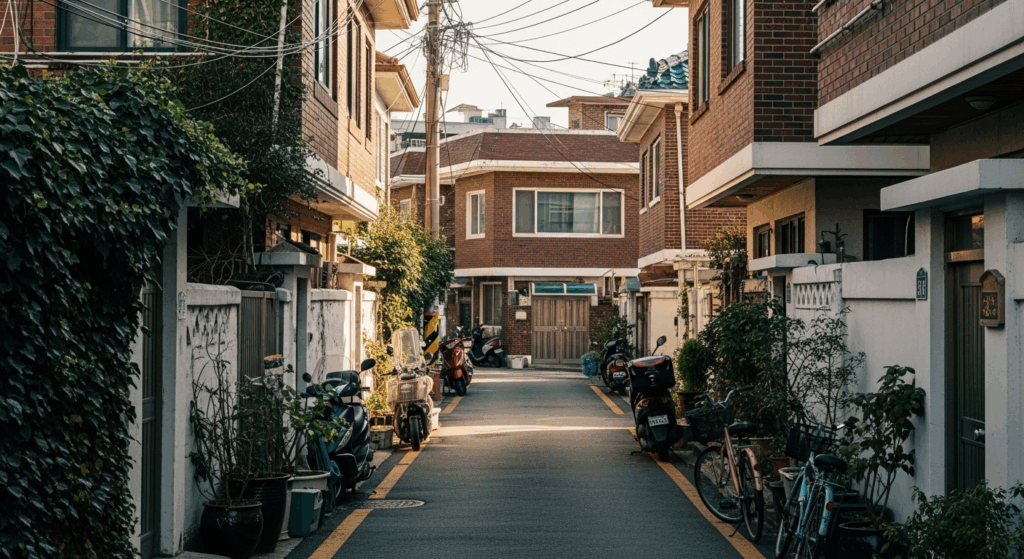
The rent you see on the listing is not the full story.
Here’s what locals quietly factor in each month:
Maintenance fee (관리비)
Most apartments and officetels charge a monthly fee covering cleaning, elevator, security, and trash.
It ranges from ₩50,000 to ₩150,000.
Sometimes includes water or heating—always ask, “관리비에 뭐가 포함돼요?”
Utilities
Electricity, gas, and water bills come separately each month.
Summer electricity (air-conditioner) and winter gas (heating) can double your bills.
Average single-person usage: ₩100,000 to ₩200,000.
Internet / Wi-Fi / TV
Three main providers: KT, SK Broadband, LG U+.
Typical combo plan costs ₩30,000–₩50,000.
Ask your landlord if the line is already active—installation for new lines can take 3–5 days.
Realtor fee (중개보수)
One-time payment to your agent.
For wolse contracts, it’s usually 0.3 to 0.9 months’ rent, depending on price bracket.
Jeonse fees are set by percentage tiers.
Ask the agent before viewing; fees are negotiable for small units.
Appliance maintenance
In officetels or villas, broken air-conditioners or boilers sometimes aren’t covered by the landlord.
Confirm in the contract who pays if repairs are needed.
Deposit return timing
At move-out, landlords usually refund your deposit after final utility bills clear.
It may take 7–14 days—plan your next rent deposit timing carefully so your cash isn’t stuck.
Example budget for a single person in Busan (typical wolse):
| Item | Average Cost (KRW) |
|---|---|
| Monthly rent (₩700,000) | ₩700,000 |
| Maintenance fee | ₩100,000 |
| Utilities (avg) | ₩150,000 |
| Internet / Wi-Fi | ₩40,000 |
| Total Monthly | ₩990,000 ≈ USD 730 |
Add groceries (₩300,000–₩400,000) and transit (₩60,000) to estimate full living costs.
Before you find an apartment in Busan, check these local tips.
💡 Local tip: Before signing, politely ask neighbors or the building manager,
“보통 관리비가 얼마예요?” (How much is the maintenance fee on average?)
That small question can save you surprise bills later.
7) How to avoid scams and stay safe

Most real estate agents in Busan are honest professionals,
but, like anywhere in the world, there are people who take advantage of foreigners who don’t know the system.
You don’t need to be afraid — just follow a few basic rules.
1️⃣ Always use a certified real estate agent (공인중개사).
Every legal office has a blue sign with the name of the licensed agent.
If you don’t see that sign, walk away.
Certified agents are registered with the government and must use standard contracts that protect both parties.
2️⃣ Never pay a deposit before signing a contract.
Some online ads (especially on Facebook or Craigslist) may ask you to send “a small reservation fee.”
Don’t.
A real agent will never ask for money before you visit and sign an official lease document.
3️⃣ Verify property ownership (등기부등본).
Ask your agent to show this document before signing.
It shows who owns the property and whether there are existing loans or legal issues.
If there’s a big loan, your jeonse deposit could be at risk.
4️⃣ Avoid emotional pressure.
Scammers often say: “Many people are interested, you must decide now!”
A real agent gives you time to think and compare.
Take photos, go home, and review calmly.
5️⃣ Use the government’s lease report system (임대차 신고제).
This simple registration at the district office officially proves your contract.
It’s free and takes 10 minutes.
If the landlord later tries to sell the building or delay your deposit return,
this report helps you get legal protection automatically.
6️⃣ Get receipts for every payment.
All payments—deposit, rent, agent fee—should go through a bank transfer, not cash.
Keep screenshots or transaction slips.
They are your best evidence if a dispute happens.
💡 Advice from my wife (licensed agent):
“If the deal feels too fast, too cheap, or too friendly, step back and check documents twice.
In real estate, patience is profit.”
8) After you move in — setting up your home smoothly

Congratulations! You’ve found your place, signed your contract, and moved in.
Now comes the part where many foreigners still feel lost — setting up utilities, paying bills, and daily living.
Electricity
You’ll receive a monthly bill from KEPCO (Korea Electric Power Corporation).
It’s written in Korean, but you can check your usage and pay easily via the KEPCO mobile app or at a convenience store (CU, GS25, 7-Eleven).
If you’re staying long-term, set up automatic payment (자동이체) with your bank.
Gas
Busan uses Busan City Gas (부산도시가스).
After moving in, call their English service line or ask your agent to register your name.
Gas bills also arrive monthly, and you can pay at a convenience store or through your bank app.
Water
Water bills come from Busan Waterworks Headquarters (부산광역시 상수도사업본부).
These are usually included in the maintenance fee (관리비) if you live in an apartment.
If not, you’ll get a separate bill every two months.
Internet and Wi-Fi
If the previous tenant already had a line installed, you can transfer the contract easily.
Otherwise, contact KT, LG U+, or SK Broadband.
Installation usually takes 3–5 days, and staff can visit even if you speak little Korean — just show your ARC and address.
Mail & deliveries
Every apartment and officetel has parcel lockers (무인택배함).
For villas or one-rooms, delivery drivers often call or message before dropping parcels.
Add your Korean phone number to every online order to avoid missed deliveries.
Noise & maintenance
If you hear loud sounds or have issues (e.g., boiler not working, water leak),
contact the building manager (관리사무소) or your landlord directly.
For apartments, the management office handles repairs quickly.
For villas, communication is usually through the agent or the owner.
When you plan to move out
Give at least 30 days’ notice before your lease ends.
Schedule your move-out inspection with your agent and landlord.
They’ll check for wall damage or unpaid bills, then return your deposit (usually within 1–2 weeks).
🌿 Local tip: Take photos of the room condition when you move in and out — walls, floor, appliances.
It prevents unfair deductions from your deposit later.
9) Conclusion — Welcome home to Busan 🏡
Finding your first apartment in Busan can feel overwhelming — new systems, new words, new contracts.
But once you go through it step by step, you’ll realize it’s not that complicated.
Korean landlords and agents are usually kind and professional when they see that you’re careful and polite.
Busan itself makes it all worth it.
Imagine waking up to the sea breeze in Gwangalli,
or watching the sunset from your balcony in Haeundae.
In Yeonsan, you’ll hear the quiet sound of neighbors sweeping their porches,
and in Seomyeon, you’ll feel the heartbeat of the city every night.
When you get your own keys, that’s the moment your real Busan life begins —
the moment you’re no longer just visiting, but living here.
Welcome home. 🗝️


